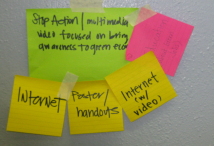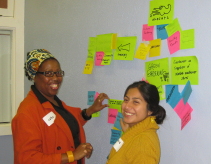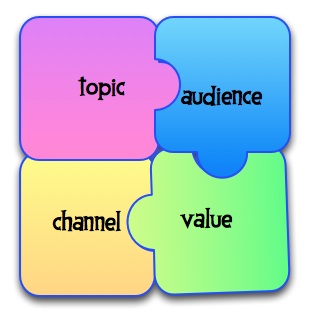Democracy is basically a system that lets people make decisions together.
The key to making that happen, besides lots and lots of meetings, is lots and lots of preparation.
The pay-off is: well-informed decision-makers, more effective meetings, and discussions that allow everyone to participate in the conversation.
Making informed decisions together is the ultimate Do-It-Together.
This post offers the first three in a series of faciltators’ tools designed to help you get this done.
SPEED DATE, SMALL GROUP AGREEMENTS, and GALLERY WALL
There are 24 people in our Community Scholars class at UCLA. Some are students, some are faculty or staff, and some are community leaders and artists.
The purpose of the class is to produce popular education material related to “Green Jobs.” We spent our four weeks in lectures and discussion with experts about aspects of the problem. Now we need to break into working teams that will produce popular education products over the next fifteen weeks. Big commitment. High stakes for the participants.
 To get those decisions started, last week we we had a three hour retreat where we engaged in the following exercises in sequence:
To get those decisions started, last week we we had a three hour retreat where we engaged in the following exercises in sequence:
Instructions for these exercises are provided below, with their purpose and goal, necessary preparation and materials, and links and images to our experience.
GOAL
The goal of this exercise is for the whole group to hear what is most important to each individual before making any assumptions or decisions. This is accomplished by each participant having a two minute conversation with every other person.
WHAT YOU WILL NEED
Time: 1.5-3 hours depending on the size of the group.
Space: a room with enough space, tables, and chairs to accommodate your participants and the room setup
Supplies:
- markers
- name tags for participants
- large colored post-it notes
- small group number signs for each small group table
- timer (kitchen timer, stop watch, cell phone)
Handouts: (with links to examples from the Community Scholars class)
Logistics:
INSTRUCTIONS
Make sure that all participants start the dating process prepared with what they want to talk about on their “dates.”
Click on the puzzle on the right to see an example of the preparation used in the Community Scholars example.
2. Speed Dates Within Small Groups
In a traditional speed date, there are two lines or two circles of men and women. One line moves to keep the “dates” going, as in this 20 second video:
But in our example, we want EVERYONE to talk to EVERYONE, so we start out in small groups to make sure that occurs.
- As people enter the room, hand each of them a small group instruction handout, and direct them to the table which is marked with the number of their small group.
- When everyone is assembled in their groups, go over the instructions and then start the speed date.
- Every minute, the Facilitator or Timer announces “SWITCH” to let people know to switch roles between who is talking and who is listening.
- Every two minutes the Facilitator or Timer announces “CHANGE PARTNERS” to let people know that it is time to do that.
- Continue in this manner until every person in the small groups has had a date with every other person in their group.
Remember, there are a lot of people talking in the room at the same time. They need to hear the instructions to “SWITCH” or “CHANGE PARTNERS.”
So don’t be shy.
3. Speed dates between the small groups.
- Assemble the small groups into paired speed-dating lines, according to your room setup plan.
- When each pair of lines has “dated” everyone in the line, create new pairs of lines according to your speed-dating plan.
Make sure you decide in advance which line is going to move down a seat when the timer announces “CHANGE PARTNERS” and which line will remain seated.
4. Break and Individual Reflection
- When everyone is done “dating”, congratulate the room.
- Give everyone a 10-20 minute break with some refreshments.
- Then hand out the individual reflection form and instruct each individual to record the themes they heard many times.
- Give everyone 5 minutes to fill out the form.
- Then dispatch them to their original small groups for the SMALL GROUP ANALYSIS exercise.
GOAL
The goals of this exercise are:
- to allow every individual to be prepared for a small group discussion;
- for the results of the small group discussion to be visually available to the larger group; and
- for those results to be produced in a form that can be physically manipulated and reorganized by other people in the next exercise.
Facilitator instructions:
- Make sure every small group has enough copies of the small group analysis forms for every member of the group.
- Make sure that each small group has colored post-it notes that reflect the different components of the discussion. (In our example, the components of our discussion were audience, topic, value, and channel. You might have different categories.)
Small group instructions:
- Pick a person to record the results of the discussion (the agreements) on one of the small group analysis forms.
- Take turns describing what you heard many times during your speed dates. You can use your individual reflection form as a reference.
- Identify the areas in which your group members have a high degree of agreement. Don’t spend a lot of time on differences because you are only going to record your agreements about what were the most frequently heard themes.
- Once those themes have been identified, write each one down on a separate post-it note of the appropriate color. Only one idea or theme per post-it note.
GOAL
The goal of this exercise is to allow the whole group to organize the discrete pieces of what they heard on their speed dates into larger, integrated ideas and themes.
Facilitator’s instructions:
- While the small groups are meeting, put category titles up on the large blank wall using post-its of the appropriate color.
- When the small groups are ready, ask all of the groups to put their colored post-its up on the wall under the appropriate heading. You will not need to track which small group put up which post-its — your goal is to build a collective picture of what everyone heard.
- Debrief the exercise by summarizing what you see and asking the participants to correct you and add more information.
Small group instructions:
- Put the post-its from the previous exercise up on the wall under the appropriate category title.
- View the whole wall as a gallery exhibition for about five minutes as a whole group.
- Then…quietly rearrange and regroup the the post-its on the wall to turn them into larger ideas or projects
Here are some examples of what our results looked like:



You now should have a pretty strong baseline that was created by everyone in the room for a more refined discussion about your projects or strategies.

QUESTIONS? COMMENTS? Post them in the comments below or email info@drpop.org


Thanks for this post – what a great way to really engage everyone a group in a decision making process to arrive at consensus. I look forward to using this technique during a future meeting I facilitate.
Hey Ron — If you do use it, would you drop a line on how it went? That would be much appreciated.
Will do. I really like the concept behind Dr. Pop – thanks for all of your work on this.
Just wanted to let you know that our project brainstorming with the UIC Community Scholars class went wonderfully last week. The speed dating exercise was a huge success and everyone had tons of fun. We also split into small groups and placed post-its on the wall, but afterwards came together as the whole group and rearranged them all together into project ideas. It was really really fantastic. Thanks Gilda for your great ideas and guidance. I will send pics from the day and from our field trip a couple of weeks ago as soon as I get them uploaded. Yea!!
We used this speeddating and it was fabulous. A great way to get people who otherwise might have had incentive to be ‘on their guard’ and therefore not moving quickly toward collaboration to connect with one another and start thinking about how they could achieve more by working together.
We did not have time in our forum to do all three steps but all stakeholders left the initial meeting agreeing that they’d like to schedule follow up to explore the ideas further… we will likely utilize the later elements in some form or other in that second meeting. I’m up for any tips others have about how we should consider doing so as part of a second meeting, rather than as part of one big meeting…
Hi Rochelle: My 2 cents:
There’s pros and cons to breaking it up into several meetings (pro: people have time to reflect; con: if you wait too long, you can lose momentum of ideas). People will remember what they said in the speed date (they said it so many times), so you can start off a follow-up meeting by building a collective picture of that, organizing it visually, and looking for patterns together.